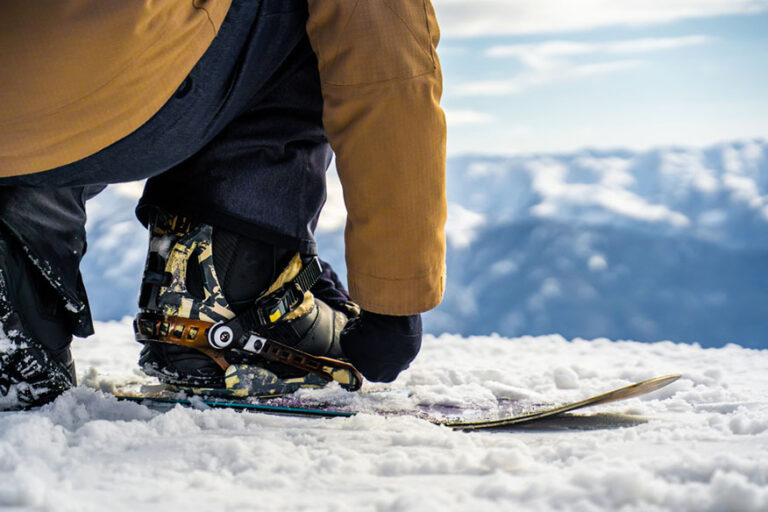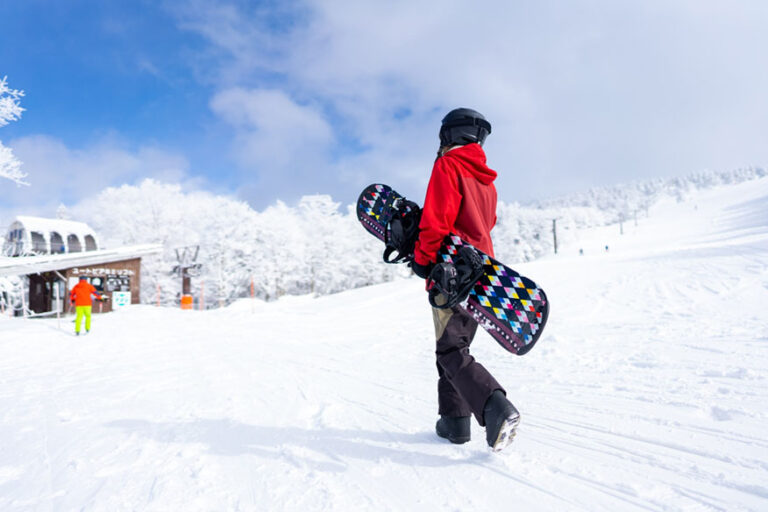Finding your stance as a snowboarder primarily comes down to trial and error. It all depends on your body type and unique preferences.
Where you place your feet on the board will determine how you ride, including steering, balance, turning, speed and coordination. Some boarders swear by a single stance, while others switch up their footing and width based on their riding style and the terrain. Use this guide to choose the right snowboard stance in every setting.
It all starts with wearing the proper gear. Do you need a helmet to snowboard? What about goggles? Make sure you’re using the right board, gloves, helmet, goggles and bindings before heading out on the slopes.
Find Your Footing
Once you’re ready to ride, you’ll need to select your dominant foot, which goes in the back, with your less prevalent foot in front. The back foot stabilizes the board and produces power, while the front foot steers and keeps balance. Your footing will either be “goofy” (right foot forward) or “normal” (left foot forward), depending on what feels natural. If you’re unsure which foot is dominant, try balancing on each to see which one is more balanced.
Find Your Width
The distance between your feet shapes how you turn and keep balance. A wider stance improves balance but reduces turning, while a narrow stance does the opposite. Most beginners use a broader stance to stay upright. The width between your bindings should be just past your shoulders. If you have a longboard and are used to surfing with a strong core, keep your feet closer together to turn quickly using your hips. Park riders and freestylers usually prefer a wider stance when navigating uneven terrain.
The width also varies depending on your height. If you’re just over five feet, your feet should be around 18 inches apart. If you’re over five feet, six inches tall, keep them 20 inches apart. Over six foot four? Your feet should be 23 to 25 inches apart.
 Source: Johnny Bravoo/Shutterstock.com
Source: Johnny Bravoo/Shutterstock.com
Most boards come with a recommended stance based on the dimensions and size. Check if the bindings are in the standard position and adjust them as needed. You may have trouble maneuvering the board if your width is too wide.
Find Your Angle
The angle of your front and back feet determines how your hips align, which affects speed, balance and turning. Most riders angle their front foot towards the nose with bindings ranging from zero — starting perpendicular to the board — to 30 degrees. Angling your front foot helps you build momentum going into a turn. Start somewhere between 15 and 22 degrees and adjust the angle from there. Racers use a more aggressive stance closer to 30 degrees to keep their hips nearly parallel to the fall line.
You also have to choose the best angle for your back foot. A positive/positive stance means both your front and back foot are pointed towards the nose, usually with the rear in the three- to six-degree range. This keeps your hips more aligned while leaning into the turn, making it easier to lean side to side.
A positive/zero stance means having your back foot perpendicular to the board. Many riders start at zero in the back and slowly angle up from there. With your back foot straight out, you can do front-facing carves and switch your dominant leg to adjust your speed and position without crossing your legs.
A positive/negative — or “duck” — stance means having your front foot angled towards the nose and your back foot angled in a negative direction toward the rear, usually between negative three and six degrees. This position allows you to ride switch, a.k.a. change dominant legs, more easily when doing tricks and adjusting your balance.
Practice with an Instructor
Change your stance as you ride to find the most comfortable position. You may need to stop every few minutes to adjust the bindings on your board. Use snowboard helmet communication to talk to your instructor hands-free as you practice getting into position. The device connects wirelessly to keep you focused on the trail ahead. They can watch your stance from a distance and suggest real-time improvements.
 Source: CandyRetriever/Shutterstock.com
Source: CandyRetriever/Shutterstock.com
Finding your stance is the first step to becoming an experienced snowboarder. If you’re having trouble turning or keeping your balance, your footing may be to blame. Remember these tips to lock in the perfect position based on your riding style.





